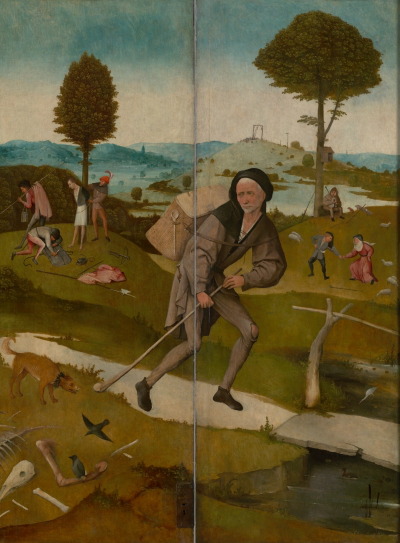The Haywain Triptych by Hieronymus Bosch was painted around 1516 and was created using oils on oak panels. It consists of one large central panel, measuring 135 x 200cm, and two smaller wings, measuring 147 x 66cm.
Introduction
He was born Jheronimus van Aken. Bosch was deeply religious and became a member of the conservative Catholic group, the Brotherhood of our Lady. In 1463, when Bosch was a teenager, ‘s-Hertogenbosch was nearly destroyed by a massive fire. It is likely that this event influenced his depictions of Hell, seen so vividly in the Haywain Triptych. One can find morality running through many of his artworks, and his triptychs would often read left to right, explaining the mistakes of man and then leading through to the resultant punishment delivered to them. Many historians have argued over different elements of Bosch's career for centuries, but most today believe that he was merely addressing religious content in a manner typical of the time. His unique characteristic, though, was the way in which he worked expressively, and with an incredible imagination that brought many of these established themes to life in a way that other artists could never manage. Hell, for example, features several times within his work and Bosch was able to bring a drama and shock to his audience in a manner that warned them directly of the dangers of leading an immoral life.
Bosch built up a large studio which enabled him to include huge amounts of detail within these panel paintings, many of which would be several metres tall. Detail and imagination were key hallmarks of his success, and his weird and wonderful creatures continue to astound art followers today. There is also something majestic and traditional about the triptych format, which connects to the respected era of North European art from the time of Van Eyck through to the Bruegel family dynasty. These were multi-sided creations which were intended to both entertain but also to educate, encouraging the viewer to follow the right moral path. A three panel series would run from left to right in a roughly chronological format, explaining the initial errors, followed by the resultant punishment. Symbolic elements would show how the right path could have been sought, but also they help us to identify examples in our own lives of potential dangers that lie ahead. Bosch wanted to appeal to the masses through his work, and so centering on the rural peasants helped everyone to connect with the messages that he had espoused.
The artist himself has managed to appeal to modern audiences, despite his career passing through some five hundred years ago. Researchers within the Netherlands continue to discover new information about his paintings, leaving us with considerable knowledge about his oeuvre, even though relatively few are attributed to his name. Most summarise his career down to the key triptychs which remain his most famous contributions, and Haywain is one of those. He offered something slightly different within the Northern Renaissance, which pushed the boundaries of content and style, leading some to be shocked by his honest, aggressive depictions. He also helped to influence how later artists would cover these same Biblical messages, providing a different atmosphere within European art. It is his individual creatures that adorn many of these large panels that excite us the most, bizarre surrealist inventions that would somehow appear contemporary all these years later. Below we examine the Haywain triptych in detail, one panel at a time, and search for the specific meanings of each element of this complex composition from the early 16th century.
Meaning
The meaning lying within The Haywain Triptych is of the need for humanity to follow the right path. This is displayed most clearly on the reverse panel, which features an old man making his way literally along a path, whilst a persistent dog attempts to distract him from his journey. Whilst this refers to temptation and danger, the inner panels go much further and reveal the harsh reality of life for those who have already succumbed. Chaos ensures within the central panel, for example, as evil starts to take over, and the true punishment is then delivered in the right hand panel, with Hell awaiting all those who have sinned. Perhaps as a sign of the significance of the outer panel wings, Bosch chose to depict the Peddler entirely in colour, when normally this section of a triptych would be entirely in Grisaille, or greyscale as many would now term it. The Haywain offers excitement and energy to the occasional enthusiast, and a much deeper meaning with layers of symbolism and morality for those willing to look a little closer.
"...In his great kindness he gave this haystack entirely to us to enjoy in peace, without quarrel or strife. But everyone wants a large portion, Fleming, German and Frenchman. Each wants the best part of the good haystack for himself..."
Van den Hopper Hoys, 1460-1470
What is a Haywain?
A Haywain is essentially a haywagon, where large loads of hay can be transported on a wheeled vehicle, pulled along by a number of horses. Within Bosch's depiction, which sits at the top of the central panel, we find a ladder being used to climb on to the tall stack of hay. The wheels themselves trap a number of figures underneath, as chaos ensues. Bosch's general comment is regards the pursuit of material goods and wealth, and the way in which this damages human behaviour, leading us towards the pain and suffering found in the next panel to the right hand side. Hay itself has been used as a slang term for Hell in some languages. Symbolically, the Haywain within this interpretation is being led to our right by a number of grotesque figures, with humans following on behind, seemingly intoxicated by their own lost minds. Capturing content from rural life focuses directly on the simplest of lives, where the ills of humanity are laid to bare in the clearest way possible, and Bruegel would later do much the same with his own depictions of low-land peasants.
Description
It also has painted shutters. The triptych was originally owned by King Philip II of Spain and displayed in his El Escorial Palace. The central panel was later owned separately by Isabella II of Spain, the left panel was acquired by the Prado Museum in Madrid, while the right panel remained at El Escorial. It was not until 1914 that the three panels of the triptych came back together in the Prado, where the triptych is currently displayed. A copy hangs in El Escorial. The painting is full of the Christian imagery and vivid, nightmarish details for which Bosch is famous. The first panel shows God casting angels out of heaven, where they turn into insects. It also shows the creation of Adam and Eve, their temptation by the Devil and their subsequent casting out from the Garden of Eden. The main panel depicts the haywain of the title, with a huge hay wagon surrounded by different types of people who are committing various sins. Christ is shown looking down upon them.
The hay cart is being drawn by an assortment of half-human demons, and these continue into the right-hand panel. This shows a scene which is either a fiery Hell or the Day of the Last Judgement. It is filled with demons who are torturing naked and half-clothed human sinners. Some of the demons are also building a pair of towers. The outside shutters of the triptych, which are revealed when the panels are closed, is painted in colour with a version of a previous Bosch painting, The Wayfarer, somtimes also known as The Peddler. The Haywain Triptych is very similar in composition to two earlier Hieronymus Bosch triptychs, The Garden of Earthly Delights and The Last Judgement. Hieronymus Bosch was a Dutch artist, who spent his whole life in the city of 's-Hertogenbosch, from where he derived the name Bosch. This project came right at the end of the artist's life, and shows his full artistic development, with many of the themes featured here having been covered several times before in other artworks.
Haywain Triptych Inside Panels
THe triptych works both from left to right, when opened, but also from the top down within the individual panels. As is typical of this artistic format, the central panel is virtually the same height as its wings, but around twice as wide. This allows the two wings to meet in the middle, which then closes the triptych and displays the artwork on the shutters instead. The three inner panels are just under one and a half metres in height, with every inch filled in detail. Several different stories are placed vertically down each panel as part of a story which draws on themes from the Bible. There is also a compositional consistency across the three inner panels, with sky scenes covering the top thirds, and then a plethora of figures based on land across the rest of each panel. This differs from some of his other triptychs, where the layout of each panel could be entirely different from its neighbouring components. The Museo del Prado, Madrid displays the full artwork today, and is open to the public, though for a number of years the individual panels were owned and displayed separately.
The Genesis of Evil and the Loss of Paradise
This panel features four clear scenes, namely The Fall of the Rebels Angels, the Creation of Eve, the Fall of Man and the Expulsion from Paradise. The content within the left hand panel perfectly lays the groundwork for all that follows as we shift to the right into the other two vertical artworks. All of those featured within this piece are caught in their own world, having lost their direction and cannot see the errors of their ways. They only look at each other, not at the viewer. The Genesis of Evil and the Loss of Paradise is predominantly completed in bright tones of green and blue with a lush foliage all around which tells of how life was to be, prior to the sins of Adam and Eve. Their own errors are shown within this piece, but the impact of those mistakes are saved for later. God himself appears high above, and as with Christ in the next iteration, his presence is ignored. It is then in Hell at the end, where is presence is entirely lost, that chaos ensues and evil begins to take over. Visual artists were able to communicate the Bible in such an effective manner, bringing their services into high demand.
The Haywain
Within the centerpiece of the triptych we find Christ only being attended to by an angel. Everyone else below is fighting over the best of the haystack for their own benefit. The Haywain itself journeys from left to right, heading towards the depiction of Hell in the next panel. The local peasants desperately throw themselves aboard, as it is led away by a series of grotesque figures. Their ignorance towards Christ as they fight over material wealth leads to their ultimate downfall, which they maybe entirely unaware of, but we can all witness from a distance. Research into the culture of the lowlands has uncovered how grass, and indeed hay, was sometimes seen as a direct summary of human life, and how it comes and goes in a cycle, just as we see within this ser of paintings. Those who look closely into this set of artworks will find many more sins featured besides greed, including lust and envy. This panel cleverly illustrates how man can be blind to its failings, and also to the path that it has taken, until it is too late.
Hell (Haywain Triptch)
Here we discover the suffering and sorrow brought about by the mistakes which have accumulated over the previous two panels. Clearly, man has diverged from the correct path as indicated on the shutter panels, and now punishment must be delivered. We find man itself stabbed, bitten and abused by nightmarish creatures who revel in their power. Flames run freely in the upper half of the composition, representing hell itself but also reminding us of the horror experienced by the artist himself during his childhood, when his family home burnt down. Many of the bizarre creatures plus the postures and actions found in this panel link us to the Surrealists of the 20th century, where imagination was encouraged to run free. Various views have been put forward over when this artwork was completed, and there still remains some question marks over where it fits into Bosch's career, if at all, but it is likely that this Hell panel came after he had already visited this theme several times over within other triptychs and also in stand-alone paintings.
Outside Shutter Panels
Triptych's outer panels have often been neglected by art historians, served up as a side note in the same way a recto and verso may be treated with famous drawings. In actual fact, these opposing sides could contain highly relevant and significant artworks which deserved much more attention. Bosch's triptychs have become so famous that, thankfully, his outer panel works have been well documented and examined, though this may in part be due to the relatively small oeuvre that the artist left behind. Typically, the panels would be opened and these outer wings would not be seen, with some artists completing them in tones of grey as a means to underlining their lack of prominence as compared to the inner panels. Both worked differently, however, and made them an important part of the narrative, essentially kicking off the story which would then continue from left to right across the open inner panels. He would also complete them in colour as a symbol of how seriously he was treating them. Some of his triptychs would be broken up, leaving the closed artwork sliced in half, but thankfully many have since been re-attached.
The Peddler
This artwork is sometimes known as The Peddler or The Wayfarer and the same theme appears again elsewhere in this artist's career. Recent examinations of the artwork have revealed details underneath the surface, including a cross which was symbolically added to the traveller's path, before later being painted over. The addition told of how this elderly figure was following Christian values as he followed the path, with the dog barking at his side representing the distractions that sometimes cause people to divert from the correct course. We find behind him a series of subtle stories which warn of what lies ahead for those who divert from the word of God, with farm workers reglecting their flock, leaving their livestock to run around in chaos. Equally, another image shows a man being robbed as he is tied to a tree, with the criminals desperately searching for items of material value, having lost their own moral compass. A series of bones are displayed along the path, representing those who left the path and consequently came a cropper. There is also a symbol of Christ's execution in the far distance, reminding us of the relevance of religion to this painting.
Date
The Haywain Triptych is loosely dated at c. 1516. Many other projects by the artist have much wider estimates, meaning there must have been more documentation available on this particular project. Sadly, the artist passed away in the year of 1516, whilst in his mid-sixties. It would therefore have been highly unlikely that any other work was completed on this painting after that date, other than potentially some final touches from members of his studio. It also means that he was at the height of his powers, as well as his artistic evolution, at the time that this piece was finished, having already covered some of the themes within this piece several times over. Bosch himself played an important role within the Northern Renaissance, arriving somewhere between the likes of Van Eyck and Bruegel the Elder, helping to carry influence and innovation through the period of the 16th century.
Location
The entire triptych remains today at the Prado Museum in Madrid, Spain, alongside a number of other notable artworks by Hieronymus Bosch. Sadly the piece was separated into its individual panels for a number of years before being brought back together in 1914. El Escorial initially received the triptych in 1570 and today holds a very accurate copy of the entire triptych whose own attribution has been mulled over by historians for centuries. The very nature of the artwork (The Wayfarer) on the closed wings means that without the three panels being displayed together, it would be incomplete. The Prado Museum hosts a room dedicated to their selection of Bosch paintings, with a number of other three-panel pieces sitting alongside this stunning masterpiece. Despite their fame for Spanish art, the institution's collection of Bosch artworks remains amongst its biggest draws to international visitors.
Medium
Hieronymus Bosch carefully constructed three oak panels with hinges connecting them together before applying layers of oil. In order for the image on the opposing sides to work effectively, the side wings would need to be correctly sized, meeting when the doors were closed. Bosch had already worked on several triptychs before and so this format was nothing new to him by this stage, and his assistants may well have helped out on the more labourious tasks. The project was deconstructed in the 19th century after being purchased by the Marquis of Salamanca, before being put back together in the early 20th century. It is unclear as to whether the existing hinges were from the original construction, or part of the more recent task of re-attaching the three artworks together. Those interested in the European Renaissance should note that oil painting started in Northern regions first, and during Bosch's career many Italians were still using fresco and tempera techniques instead. The Bosch Research and Conservation Project discovered new information on many of this artist's paintings relatively recently, and we do now know that Bosch himself made use of azurite, lead-tin yellow, vermilion and ochres as part of a fairly small palette.
Large Image of Bosch's Haywain Triptych
The very nature of this artist's triptych panels means that small digital images of the paintings as a whole do not really get across the stunning detail that he added all those centuries ago. As such, we have separated the panels individually and shown images of each one, as well as including a larger image of the inner panels together below. There is an abundance of life and activity to be found in each of the three inner panels, particularly near the bottom of each one. There is not just a morale message to be found within the content, but also plenty of fun and entertainment which Bosch realised was the best way to get his point across. Many will be reminded of some of the peasant depictions by Bruegel when viewing Bosch's Haywain Triptych, and indeed he was significantly influenced by his North European counterpart.
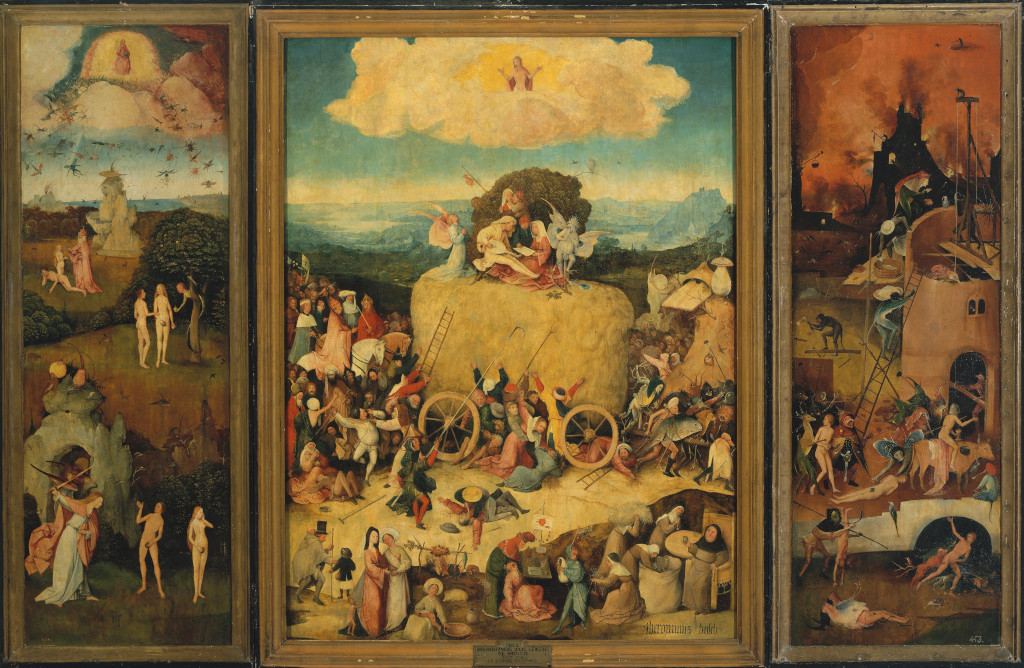



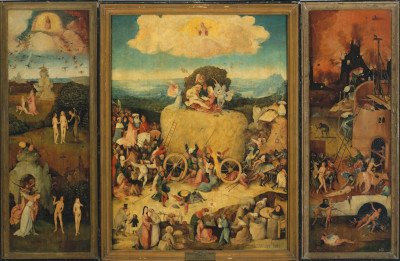
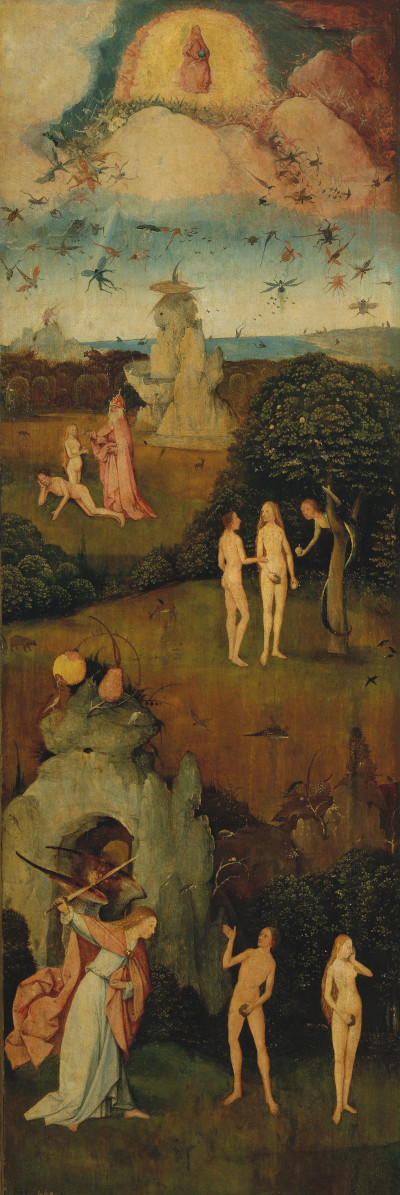
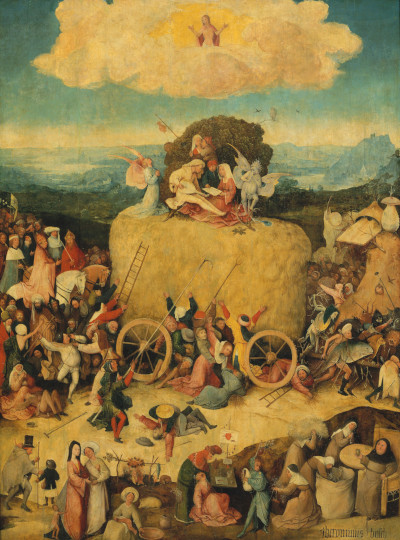
 Hieronymus Bosch.jpg)
